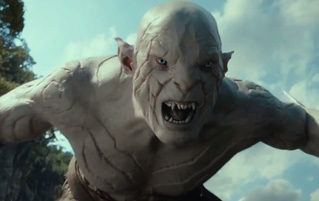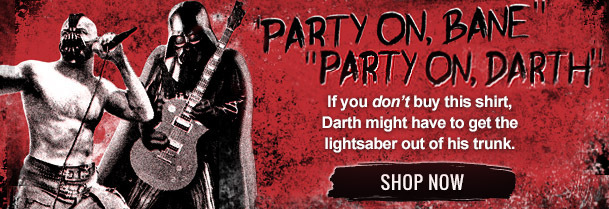4 Reasons Movie Special FX Are Actually Getting Worse

When every summer movie is like 80 percent special effects and 20 percent actual people (mostly Gary Oldman), it might be time to stop calling them "special." It's gotten so ridiculous that pretty soon IMDb is going to have to create new categories for all those digital hair tracers, ab sculptors, and dick jiggle physics specialists working on every movie. Unfortunately, past the flashy visuals and explosions of the big screen lies the seedy underbelly of the visual effects industry, which involves shady dealings like ...
Visual Effects Are Making Even the Best Filmmakers Lazy
Fun fact: Here's what the orcs in The Hobbit almost looked like.

Congratulations, you're now suffering from metal poisoning just from this picture.
And, of course, here's what we ended up with:

Never mind, you're cured.
What the hell happened? A phenomenon we've lovingly named the CGI effect ... effect.
As we've mentioned before, Peter Jackson's attention to detail on the Lord of the Rings trilogy was so insane that every armor was crafted based on the backstory of an orc, most of which were onscreen for a whole six frames before being decapitated -- not only that, costume designers painstakingly handcrafted over six miles (for metric enthusiasts, that's "a shitload of kilometers") of chain mail, just so that they could put them on orc actors who would be wearing armor over the mail, at night, in the rain. After Jackson was dragged kicking and screaming back to the director's chair for The Hobbit, though, he said to hell with that and created all the orcs in nice and easy (for him) CGI. Hence the buttlord in the screencap above.
And The Hobbit trilogy is just one example in an increasingly disturbing trend of filmmakers who use CGI where practical effects would at least suffice, if not be better. Check out this supercut of VFX from The Expendables 2, where CGI was used for breathtaking effects like making a white helicopter black:

The same technique was used on the cast's hair.
Or the scene where Sly sends a CGI motorcycle careening off a ramp into a CGI helicopter. We're talking about the same guy who became a film legend by actually jumping off cliffs and getting knocked out on camera. But, OK, maybe the helicopter/bike thing isn't such a good example, because when have you ever seen a scene like that using practical effects?

Oh.
Yes, even the lesser Die Hards have more balls than today's movies: the famous helicopter scene from Live Free or Die Hard was filmed using a real car, helicopter, and pee-soaked stunt man, with only a dash of CGI to make it a little bit more explodey in the finished film.
The CGI effect effect is even working its way into non-genre films. For The Wolf of Wall Street, Martin Scorsese apparently got tired of scouting locations, so he just filmed his scenes wherever he set up his camera and then Photoshopped the proper background in later:

The Jonah Hill cocaine party was filmed at a completely different Jonah Hill cocaine party.
At least the CGI companies must be getting loaded from all this extra business, right? Nope. It's the opposite, actually, because ...
Studios Pick Whichever VFX Company Is Most Desperate
Remember that big Noah movie with Russell Crowe that came out this year? The one that featured every animal ever, a world-ending flood, and (for some reason) giant rock monsters, all made from CGI? Guess how much money the visual effects company made from that gig. If you guessed "nothing," then you're wrong -- it's less than that. They actually lost money for the "privilege" of working on a $125 million movie that racked up $359 million worldwide.

At least they managed to cut corners by having the studio execs pose for this shot.
And that's not a fluke: that's just how the visual effects business works today. There are so many VFX shops vying for a limited number of movies that, instead of hiring them based on any measure of skill, studios are literally handing over their multi-million-dollar investments to the lowest bidder. Hell, tell them you can do Avengers 2 on MS Paint for $5 and you've got yourself a contract. Basically, picture the special effects companies as violently detoxing meth addicts and the movie studios as unscrupulous dealers with blue balls. Now do the math.

This scene was painfully familiar for the artists.
In turn, this means that the VFX companies have to take on so much work to try to turn even a meager profit that their artists end up working 15-hour days for weeks at a time, on top of cutting frivolities like health insurance or overtime, just to keep their lights on. The Noah company, Look Effects, isn't some little start-up: they also did the CGI on shows like Lost and Game of Thrones. However, the only way they could land Noah was by low-balling it, and then it's not like they could go back to the studio and say, "Hey, so, apparently we can't generate an apocalyptic flood and some 3 million odd animals stuffed on to a giant boat for the price of a Happy Meal."
Their only hope, at this point, is to deliver something badass enough to impress other studios (and hopefully get a little golden statue). Of course, to do that, that probably means you're going to have to cough up for good CGI, and the slight problem there is ...
Good CGI Is So Expensive That It's Putting Companies Out of Business
You've probably noticed that not all CGI is born equal. There's the good stuff, like the seamless effects in Gravity ($100 million), which are like eating a fine steak through your eyes. And then you've got the Syfy-level digital turds in movies like R.I.P.D. ($130 million), which would be the equivalent of drinking a hobo's piss -- why do these companies let that happen? In many cases, because the alternative is to end up being that hobo.

"You think we chose this?!"
It turns out that making the most visually spectacular images that the human brain can comprehend requires a good bit of scratch. That's why huge-budget blockbusters have been becoming the norm (33 of the 50 most expensive movies of all time have been made in the last four years); studios are so preoccupied pouring hundreds of millions of dollars into CGI for schlock like Battleship because they could, that they didn't bother to stop to think if they should.
And, as CGI continues to improve, movies only become more reliant on it. We've mentioned before how Rhythm & Hues, the visual effects company most famous for bringing to life all the Oscar-winning, pants-shitting fear of sharing a Tunnel of Love rowboat with a 400-pound marvel of evisceration and death in Life of Pi, went bankrupt because they did their job too well.

"We were worried about that for a minute, too."
Meanwhile, the studios are pumping more and more money into already-bloated special effects budgets (it sure as shit isn't going toward better screenplays). For Transformers: Thing of Whatever, Industrial Light & Magic spent about 15 weeks per Transformer just getting the basic model ready, and each model has about 10,000 parts -- that's not a joke, that's seriously how many individual pieces there are in Michael Bay's idea of a talking truck. The company had to start making models six months before filming even started, just to meet the production schedule. And remember, ILM is like the GE of special effects studios, so if they're balls-to-the-wall to make their effects look good in a profitable fashion, what chance does a scrappy, upstart VFX company have?
The over-CGI-ing of movies is having one positive effect, though ...
Practical Effects Are Becoming Cool Again
The upside of all this bullshit is that we the viewers aren't the only ones getting fed up with it: some filmmakers are too. We recently told you about that new '80s-style horror film that got Kickstarted into existence, but they're not the only ones trying to bring practical effects back into fashion. For as much crap as we gave Christopher Nolan for the brain assault he's putting together for Interstellar, one of the big draws for the movie is that he's limiting CGI to the purpose it was originally meant for: that is, creating things that cannot physically exist in reality.

McConaughey is physically incapable of crying since a thong-related accident on Magic Mike.
Jurassic Park was famous for being one of the first movies to incorporate extensive use of CGI effects. But as mind-blowing as those effects were, people often forget that they were used to supplement the mind-blowing-est practical effects, not replace them. Of the 15 or so minutes of dinosaur screen time in the movie, CGI was used for about six minutes. The rest was done with puppets, people in costumes, and good old-fashioned robots:
Well, for the upcoming sequel, Jurassic World, they've promised to continue to use animatronic dinosaurs. The same goes with the special effects for Episode VII and VIII. Hey, do you think that might be why the Internet had a joygasm when there was even a hint that the original Star Wars trilogy might be released on Blu-ray without all the Special Edition shit thrown in? Things are looking up again, finally!
Oh, except for the VFX companies. They're still fucked, probably.
When Chris isn't launching motorcycles into helicopters, he writes for his website and tweets.
For further Tinseltown chicanery, check out 5 Sequels That Created Hilarious Plot Paradoxes and 4 Awesome Marvel Movie Scenes You'll Never See (And Why).
